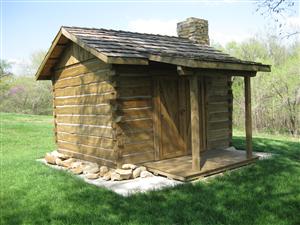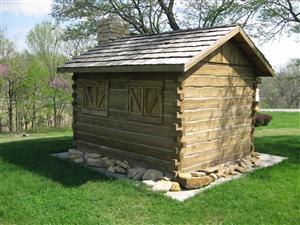The Battle of Fort Titus
Tour Stop
Directions: A replica of Fort Titus [ Waypoint = N39 02.667 W95 23.487 ] is located near the Territorial Capitol Museum at 640 E. Woodson, Lecompton, Kansas 66050 Fort Titus was originally located in the same general area as a present day Propane Gas Terminal[ Waypoint = N39 01.418 W95 23.465 ] along County Road 1029.
Description: Fort Titus was a fortified log cabin owned by Colonel Henry T. Titus that was located about 2 miles south of Lecompton on the east bank of Coon Creek. Colonel Titus was a pro-slavery man who had taken part in the Sack of Lawrence.
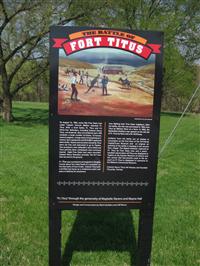
There is an interpretive sign that has the following text:
The Battle of Fort Titus
On August 16, 1856, some fifty Free State men under Captain Samuel Walker attacked Ft. Titus. After a brief battle, Ft. Titus and its thirty-four defenders, including Colonel Henry Titus, surrendered. Also surrendered were 400 muskets, a large number of knives, 13 horses, several wagons, a large stock of household provisions, farm equipment and $10,000 in gold and bank drafts. Slaves and servants owned by Titus were set free and instructed to go to Topeka. Two proslavery men defenders were killed and Titus and five other combatants were seriously injured. Eight free state men were wounded, Captain Henry Shombre mortally. The fort was then burned to the ground.
Ft. Titus was a proslavery stronghold in Douglas County about two miles south of Lecompton on the east bank of Coon Creek. Colonel Henry Titus built a fortified log house as a rendezvous point and place of defense for proslavery men fighting their Free State neighbors. After the battle, the site was purchased in 1856 from Titus by William Nace as a farm. In 1860, the Battlefield Distillery was opened on the old site of Ft. Titus by Nace and a Mr. McKinney.
Artifacts from the battle are on display in Lecompton on the first floor of the Territorial Capitol/Lane Museum and an oil painting of the battle is hanging in the second floor chapel. The Abbott Howitzer captured at Ft. Titus by Free State men and a pearl-handled sword taken off Titus are displayed in Topeka at the Kansas Museum of History and the cannon Old Sacramento used in the assault on Ft. Titus is displayed in Lawrence at the Watkins Community Museum.
Colonel Henry Titus left Kansas and founded Titusville, Florida.
“Ft. Titus” through the generosity of Maybelle Slavens and Wayne Hall.
Design and Construction by Welch Builders and Jeff Morris.
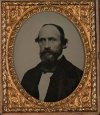 Charles Robinson was one of the more moderate free state leaders and felt that violence was counterproductive. Following his arrest during the Sack of Lawrence in May of 1856, the more militant free state leaders, Jim Lane and John Brown, would yield more influence over events.
Charles Robinson was one of the more moderate free state leaders and felt that violence was counterproductive. Following his arrest during the Sack of Lawrence in May of 1856, the more militant free state leaders, Jim Lane and John Brown, would yield more influence over events.
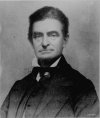 Just a few days after the Sack of Lawrence, John Brown would lead a small band and commit the killings that would become known as the Pottawatomie Massacre. Then in June at the Battle of Black Jack, John Brown would lead a small force of free state militia and capture a pro-slavery militia under the command of Henry C. Pate.
Just a few days after the Sack of Lawrence, John Brown would lead a small band and commit the killings that would become known as the Pottawatomie Massacre. Then in June at the Battle of Black Jack, John Brown would lead a small force of free state militia and capture a pro-slavery militia under the command of Henry C. Pate.
 Jim Lane also went on the offensive. At first, Lane had planned on using force to free Charles Robinson, John Brown, Jr. and the other free state leaders that were being held prisoner in Lecompton, Kansas. But he decided to attack and destroy three fortified log cabins located several miles from Lawrence. These forts were pro-slavery strongholds that were used by pro-slavery militia for staging raids against free state men.
Jim Lane also went on the offensive. At first, Lane had planned on using force to free Charles Robinson, John Brown, Jr. and the other free state leaders that were being held prisoner in Lecompton, Kansas. But he decided to attack and destroy three fortified log cabins located several miles from Lawrence. These forts were pro-slavery strongholds that were used by pro-slavery militia for staging raids against free state men.
Franklin was located a few miles to the southeast of Lawrence. Jim Lane took a force of about 100 free state militia and surrounded some pro-slavery militia who were holed up in a fortified log cabin known as Fort Franklin. After several hours of fighting, to little effect, the free-state men were able to set the cabin on fire. This caused the pro-slavery men to flee from the scene. The victorious free staters captured a number of arms and a cannon, known as “Old Sacramento”.
Lane called for and received reinforcements from Lawrence, before proceeding to his next target, Fort Saunders. Fort Saunders was a fortified pro-slavery camp located on Washington Creek about 12 miles southwest of Lawrence. As the free state force approached Fort Saunders on August 15th, the pro-slavery defenders decided to withdraw without a fight.
The next day, the free state militia took the fight towards Lecompton. Fort Titus was a fortified log cabin owned by Colonel Henry T. Titus that was located about 2 miles south of Lecompton on the east bank of Coon Creek. Colonel Titus was a pro-slavery man who had taken part in the Sack of Lawrence.
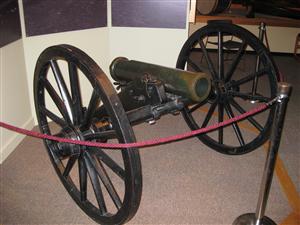 By now, the free state militia had grown to around 400 men. Lane was not present, but in command of the free state militia was his friend, Captain Samuel Walker. Walker took a force of about 50 men and attacked the fortified cabin. The cannon, “Old Sacramento,” captured at Fort Franklin was used against Fort Titus. Lead type from the Lawrence newspaper, Herald of Freedom, was melted into the shot used in the cannon that fired on Fort Titus. The pro-slavery men in the cabin would surrender after a short fight. Colonel Titus and about 34 of his men were captured. The Abbot Howitzer taken by pro-slavery militia during the Sack of Lawrence, was recaptured. The victorious free-state men burned Fort Titus.
By now, the free state militia had grown to around 400 men. Lane was not present, but in command of the free state militia was his friend, Captain Samuel Walker. Walker took a force of about 50 men and attacked the fortified cabin. The cannon, “Old Sacramento,” captured at Fort Franklin was used against Fort Titus. Lead type from the Lawrence newspaper, Herald of Freedom, was melted into the shot used in the cannon that fired on Fort Titus. The pro-slavery men in the cabin would surrender after a short fight. Colonel Titus and about 34 of his men were captured. The Abbot Howitzer taken by pro-slavery militia during the Sack of Lawrence, was recaptured. The victorious free-state men burned Fort Titus.
During the fighting, US Troops stationed nearby at Camp Sackett would deploy north of Fort Titus and prevent the free state militia from marching against Lecompton.
Charles H. Caulkins, a free-state man who had emigrated from Maine, later testified about what he had seen during the fighting at Fort Titus:
“Capt. Walker was in command...On Saturday 16th we were called up by daylight & marched off without any thing to eat about 2 miles to the house of Titus. The order was given by Walker for only the horsemen to go & for the infantry to remain behind. But Harvey said “gear up our teams we will go as well as horsemen” so we started leaving all the main body of infantry behind. We started ahead of the cannon. When within 20 rods of the house a messenger met us & told us to push on saying there was plenty of fun ahead – that Showbre was killed & 2 or 3 more shot. We were there in line when the cannon arrived though the cannon was drawn by horses.”
“Harvey ordered us to fire low. We fired two more volleys: the cannon fired at the same time. This was about 6 in the morning. 4 rounds were fired from the cannon without taking effect. The 5th shot took effect entering the house just above 1st floor and knocking things about some. This ball was made of the type of the Herald of Freedom & was considered a successful edition ... After their white flag was observed, the fire ceased, and rushing up to the house our company were the first men in: one of us arrested Titus & MacArthur was placed guard over him by Harvey. The brave Col Titus was found secreted under the floor boards in a corner ... Capt Walker came up & took possession of Titus when a soldier rushed up with the butt of his musket raised to dash his brains out. Walker ordered him to desist & saved Titus’ life. We set fire to the house & retired. We reached Lawrence about 2 P. M. with our prisoners and met with a welcome reception from the inhabitants.”

